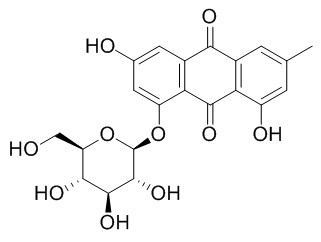Emodin-8-beta-D-glucoside
Emodin-8-beta-D-glucoside functions to protect from focal cerebral injury induced by ischemia and reperfusion. It directly stimulates cell proliferation and differentiation of osteoblasts.
Inquire / Order:
manager@chemfaces.com
Technical Inquiries:
service@chemfaces.com
Tel:
+86-27-84237783
Fax:
+86-27-84254680
Address:
1 Building, No. 83, CheCheng Rd., Wuhan Economic and Technological Development Zone, Wuhan, Hubei 430056, PRC
Providing storage is as stated on the product vial and the vial is kept tightly sealed, the product can be stored for up to
24 months(2-8C).
Wherever possible, you should prepare and use solutions on the same day. However, if you need to make up stock solutions in advance, we recommend that you store the solution as aliquots in tightly sealed vials at -20C. Generally, these will be useable for up to two weeks. Before use, and prior to opening the vial we recommend that you allow your product to equilibrate to room temperature for at least 1 hour.
Need more advice on solubility, usage and handling? Please email to: service@chemfaces.com
The packaging of the product may have turned upside down during transportation, resulting in the natural compounds adhering to the neck or cap of the vial. take the vial out of its packaging and gently shake to let the compounds fall to the bottom of the vial. for liquid products, centrifuge at 200-500 RPM to gather the liquid at the bottom of the vial. try to avoid loss or contamination during handling.
Korean Journal of Pharmacognosy2019, 50(4):285-290
Int J Mol Sci.2023, 24(4):3682.
Food Chem.2019, 275:746-753
Molecules.2019, 24(23):E4303
J Nat Prod.2017, 80(4):854-863
J Ethnopharmacol.2017, 198:205-213
J Cell Mol Med.2024, 28(16):e70015.
Antioxidants (Basel).2024, 13(12):1530.
iScience.2020, 23(2):100849.
Food Hydrocolloids2024, 156:110345
Related and Featured Products
Molecules. 2011 Jan 18;16(1):728-37.
Emodin-8-O-β-D-glucoside from Polygonum amplexicaule D. Don var. sinense Forb. promotes proliferation and differentiation of osteoblastic MC3T3-E1 cells.[Pubmed:
21245807 ]
Polygonum amplexicaule D. Don var. sinense Forb. (Polygonaceae) (PAF) is a famous traditional herb used to treat fractures, rheumatoid arthritis, muscle injury and pain.
METHODS AND RESULTS:
The present study was designed to investigate a PAF derived-chemical compound Emodin-8-beta-D-glucoside (EG) on the proliferation and differentiation of osteoblastic MC3T3-E1 cell in vitro. A compound was isolated from PAF extract by HPLC and identified as emodin-8-O-β-D-glucoside (EG) by spectroscopic methods. EG significantly promoted cell proliferation at 0.1-100 ng/mL, and increased the cell proportion in S-phase from 16.34% to 32.16%. Moreover, EG increased alkaline phosphatase (ALP) expression in MC3T3-E1 cells at the concentration from 0.1 to 100 ng/mL and inhibited PGE(2 )production induced by TNF-α in osteoblasts at the concentrations ranging from 10-100 ng/mL, suggesting that cell differentiation was induced in MC3T3-E1 osteoblasts.
CONCLUSIONS:
Taken together, these results indicated compound EG directly stimulated cell proliferation and differentiation of osteoblasts, therefore this study preliminarily explored the pharmacological mechanism of PAF to promote the healing of bone rheumatism and various fractures.
Eur J Pharmacol. 2007 Dec 22;577(1-3):58-63.
Neuroprotective effects of emodin-8-O-beta-D-glucoside in vivo and in vitro.[Pubmed:
17897641 ]
Emodin-8-O-beta-D-glucoside(Emodin-8-beta-D-glucoside) extracted from the traditional Chinese medicinal herb Polygonum cuspidatum Sieb. et Zucc is widely used to treat acute hepatitis possibly by antioxidative mechanisms. The present study was designed to investigate whether emodin-8-O-beta-D-glucoside(Emodin-8-beta-D-glucoside)exerted neuroprotective effects on the focal cerebral injury induced by ischemia and reperfusion in vivo and on the neuronal damage induced by glutamate in vitro, and to study the possible mechanisms.
METHODS AND RESULTS:
Male Wistar rats were used to establish the model of ischemia and reperfusion. The behavioral test was performed and the cerebral infarction area was assessed in the brain slices stained with 2% 2,3,5-triphenyl tetrazolium chloride to evaluate the neuroprotective effects of emodin-8-O-beta-D-glucoside(Emodin-8-beta-D-glucoside). Superoxide dismutase (SOD) activity, total antioxidative capability and malondialdehyde (MDA) level in the brain tissue were determined with spectrophotometrical methods to probe the primary mechanisms of emodin-8-O-beta-D-glucoside(Emodin-8-beta-D-glucoside). In vitro, the neuroprotective effects of emodin-8-O-beta-D-glucoside(Emodin-8-beta-D-glucoside) were tested in the cultured cortical cells of fetal rats exposed to glutamate. Emodin-8-O-beta-D-glucoside(Emodin-8-beta-D-glucoside) concentration in plasma and brain tissue was also measured to examine distribution of emodin-8-O-beta-D-glucoside(Emodin-8-beta-D-glucoside) in the brain. The results showed that the treatment of rats with emodin-8-O-beta-D-glucoside(Emodin-8-beta-D-glucoside) reduced the neurological deficit score and the cerebral infarction area, increased SOD activity and total antioxidative capability, and decreased MDA level in the brain tissue in dose-dependent way. Emodin-8-O-beta-D-glucoside(Emodin-8-beta-D-glucoside) also inhibited the neuronal damage induced by glutamate. Besides, emodin-8-O-beta-D-glucoside(Emodin-8-beta-D-glucoside) was able to penetrate blood-brain barrier and distribute in the brain tissue.
CONCLUSIONS:
These findings demonstrate that emodin-8-O-beta-D-glucoside(Emodin-8-beta-D-glucoside) is able to provide neuroprotection against cerebral ischemia-reperfused injury and glutamate induced neuronal damage through exerting antioxidative effects and inhibiting glutamate neurotoxicity.
J Chromatogr A. 2006 May 19;1115(1-2):64-71.
Preparative isolation and purification of chemical constituents from the root of Polygonum multiflorum by high-speed counter-current chromatography.[Pubmed:
16564530]
High-speed counter-current chromatography methods, combined with solvent partition, were applied to the systematic separation and purification of chemical components from Chinese medicinal herb Polygonum multiflorum extract. The aim of this paper is summing up the rules of solvent system selection for diverse fractions of herbal extract, and establishing the systematic pattern to screen the bioactive constituents rapidly.
METHODS AND RESULTS:
Nine compounds including emodin, chrysophanol, rhein, 6-OH-emodin, Emodin-8-beta-D-glucoside, polygonimitin B, 2,3,5,4'-tetrahydroxystilbene-2-beta-D-glucoside, gallic acid and an unknown glycoside, which differed in quantity and polarity remarkably, were obtained. The purities of them were all above 97% as determined by high-performance liquid chromatography (HPLC), and their structures were identified by 1H NMR and electrospray ionization mass spectrometry (ESI-MS).
CONCLUSIONS:
The results demonstrated that HSCCC is a speedy and efficient technique for systematic isolation of bioactive components from traditional medicinal herbs.



